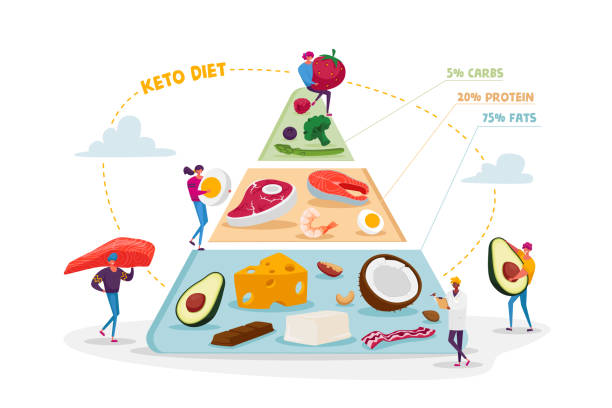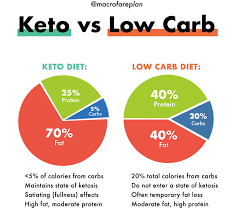
INTRODUCTION
As of late, the universe of nourishment has seen a flood in the prevalence of low carb (low carb) and ketogenic (keto) consuming fewer calories. These dietary methodologies definitely stand out for their capability to assist with weight reduction, work on metabolic well-being, and even deal with specific ailments. Notwithstanding, the distinctions between low-carb and keto diets can be confounding, driving numerous to ponder which one is appropriate for them. In this thorough aid, we will dive profound into the low carb vs keto diet banter, investigating their standards, benefits, likely disadvantages, and who ought to think about every choice.
UNDERSTANDING LOW-CARB DIET
As the name recommends, a low-carb diet confines your day-to-day sugar consumption. Bread, pasta, rice, organic products, and vegetables are all sources of starches, which are one of the three macronutrients, along with proteins and fats. The essential objective of a low-carb diet is to restrict the admission of these carb-rich food sources, regularly to 20-50 grams of net carbs each day, however, this can change contingent upon individual objectives and requirements.

PRINCIPLES OF A LOW CARB DIET
1.) Carb Limitation: The foundation of a low-carb diet is limiting sugar consumption. Thus, the body is compelled to involve fat as its essential wellspring of energy rather than carbs.
2) Center around Protein and Fats: To make up for the decrease in carbs, a low-carb diet stresses the utilization of protein and sound fats. This gives energy and advances satiety.
3) Plants and fibre: In spite of the fact that carbs are restricted, non-bland vegetables are frequently urged because of their high fibre content and negligible effect on glucose.
BENEFITS OF A LOW-CARB DIET
1) Weight reduction: A low-carb diet can prompt huge weight reduction by diminishing calorie consumption and advancing fat consumption.
2) Glucose Control: Low-carb diets can assist with balancing glucose levels, making them an important choice for people with diabetes or insulin obstruction.
3) Further developed Heart Well-being: A few investigations propose that low-carb diets might further develop cardiovascular gamble factors, like bringing down fatty substances and expanding HDL (great) cholesterol.
4) Improved Mental Lucidity: On a low-carb diet, some people say they have better mental clarity and less brain fog, but each person’s experience may be different.

UNRAVELING THE KETOGENIC DIET (KETO)
The ketogenic diet, frequently alluded to as the keto diet, takes carb limitation to a higher level. It is a super low-carb, high-fat eating regimen that powers the body into a condition of ketosis. Ketosis is a metabolic state where the body consumes fat for fuel, incorporating the fat put away in your body, which can prompt quick weight reduction.

PRINCIPLES OF A KETO DIET
1) Outrageous Carb Limitation: A keto diet ordinarily restricts day to day carb admission to around 20-50 grams of net carbs, for certain people going as low as 10 grams. This serious carb limitation is the way to accomplish and keep up with ketosis.
2) High Fat Admission: Roughly 70-80% of day-to-day calories on a keto diet come from sound fats, like avocados, nuts, seeds, and oils.
3) Moderate Protein: Protein admission is moderate, ordinarily involving around 15-20% of day to day calories. Consuming a lot of protein might possibly ruin ketosis, as an overabundance of protein can be changed over into glucose.
4) Ketosis: The state of ketosis, in which the body produces and uses ketones as its primary source of energy, is the hallmark of the keto diet.
Also Read: 1200 Calories Keto Diet Plan
BENEFITS OF A KETO DIET
1) Rapid Loss of Weight: Because of the exceptional decrease in carb consumption and the shift to consuming fat for fuel, many individuals experience fast weight reduction on a keto diet.
2) Glucose Control: Like low carb eats less carbs, keto diets can assist with settling glucose levels and further develop insulin awareness.
3) Treatment for Epilepsy: The ketogenic diet was at first evolved as a treatment for epilepsy, and it stays an important choice for people with drug-safe epilepsy.
4) Upgraded Mental Concentration: A few people report expanded mental clearness and worked on mental capability while in ketosis.
LOW CARB VS. KETO: KEY DIFFERENCES
Now that we have a solid understanding of both low-carb vs keto diets, let’s highlight some key differences between the two:
1) Carb Admission: The essential differentiation lies in carb admission. Low carb eats less take into consideration greater adaptability, normally going from 20-50 grams of net carbs each day, while keto consumes fewer calories is very prohibitive, holding back nothing grams or significantly less to accomplish and keep up with ketosis.
2) Fat Substance: Keto eats less underscore a lot higher fat admission (70-80% of calories) contrasted with low carb slims down, which centre around moderate fat utilization.
3) Protein Control: Protein admission is for the most part moderate in the two eating regimens, yet it requires stricter checking on a keto diet to forestall extreme protein consumption, which can upset ketosis.
4) Ketosis: Accomplishing and keeping up with ketosis is the essential objective of a keto diet, while low carb consumes fewer calories it doesn’t guarantee to require this state

WHO SHOULD CONSIDER A LOW-CARB DIET?
A low-carb diet can be a suitable choice for a wide range of individuals, including:
1) Those Looking for Feasible Weight Reduction: If you have any desire to get in shape while as yet partaking in different food varieties and somewhat greater adaptability in your eating routine, a low-carb approach might be ideal.
2)People with Type 2 Diabetes: Low-carb diets are an option for people with these conditions because they have been shown to improve insulin sensitivity and blood sugar control.
3) Athletes: For certain training phases, such as fat adaptation or periods of lower-intensity training, some athletes may benefit from a low-carb diet.
4) Individuals with Cardiovascular Worries: Low-carb slims have shown potential in further developing heart well-being by bringing down fatty oils and expanding HDL cholesterol levels.
WHO SHOULD CONSIDER A KETO DIET?
The ketogenic diet is more specialized and is best suited for:
1) Those needing Fast Weight reduction: In the event that you have a lot of weight to lose and are OK with the severe dietary limitations, a keto diet can prompt fast starting weight reduction.
2) People with Medication-Safe Epilepsy: The keto diet is an important choice for those with epilepsy that doesn’t answer medicine.
3) Individuals with Neurological Circumstances: Some examination proposes that keto diets might be valuable for other neurological circumstances like Parkinson’s infection and Alzheimer’s sickness, albeit more investigations are required.
4) Competitors and High-intensity games: While not appropriate for extreme focus sports, keto diets might help perseverance competitors who depend on fat for energy during long-span exercises.
POTENTIAL DRAWBACKS OF LOW-CARB AND KETO DIETS
Before embarking on either a low-carb or keto diet, it’s important to be aware of potential drawbacks and considerations:
1) Keto Flu: Many people experience the “keto flu” during the initial stages of a ketogenic diet, which can include symptoms like fatigue, headaches, and nausea. This usually subsides as the body adapts to ketosis.
2) Limited Food Choices: Both diets can limit food variety, which may lead to boredom and difficulty sticking to the plan long-term.
3) Nutrient Deficiencies: Depending on food choices, deficiencies in essential nutrients like fiber, vitamins, and minerals can occur. It’s crucial to plan a balanced diet within the chosen dietary framework.
4) Social Challenges: Social situations and dining out can be challenging on both diets, as they often involve carb-rich foods.
5) Potential Long-Term Health Effects: The long-term health effects of these diets are still under investigation. Some concerns exist regarding the impact on heart health, kidney function, and bone health, so it’s essential to consult with a healthcare provider before embarking on a prolonged low-carb or keto diet.

CONCLUSION
The question regarding the low-carb VS keto diet has no one-size-fits-all answer. The ideal choice for you will depend on your unique goals, preferences, and health considerations. While keto consumes fewer calories, with its strict carbohydrate restrictions, is fantastic for quick weight loss and managing certain conditions, low carb eats less carbs offers better flexibility and may be good for affordable weight loss and glucose control.
Prior to beginning any dietary routine, it’s significant to talk with a medical care proficient or an enlisted dietitian to guarantee it lines up with your well-being objectives and requirements. Despite which way you pick, a decent and very much arranged way to deal with nourishment is vital to making long-haul progress and keeping up with great well-being.
FAQs
Be that as it may, a low-starch diet can be gainful for weight reduction, diabetes, and cardiovascular gambling, regardless of whether an individual enters ketosis. The lazy keto diet may help people avoid heavily refined foods and added sugars by limiting carbohydrates to 10% or less.
To oversee or forestall diabetes, the American Diabetes Affiliation suggests the Mediterranean eating regimen and other low-carb abstains from food, as long as they limit added sugars and refined grains and incorporate non-dull vegetables. The super low-carb ketogenic diet satisfies these models.
Yet, there’s no conclusive exploration looking at low-carb versus ketogenic slims down with regards to weight reduction, despite the fact that narrative reports show that keto calorie counters are probably going to lose more weight, all the more rapidly, over a shorter period of time.
